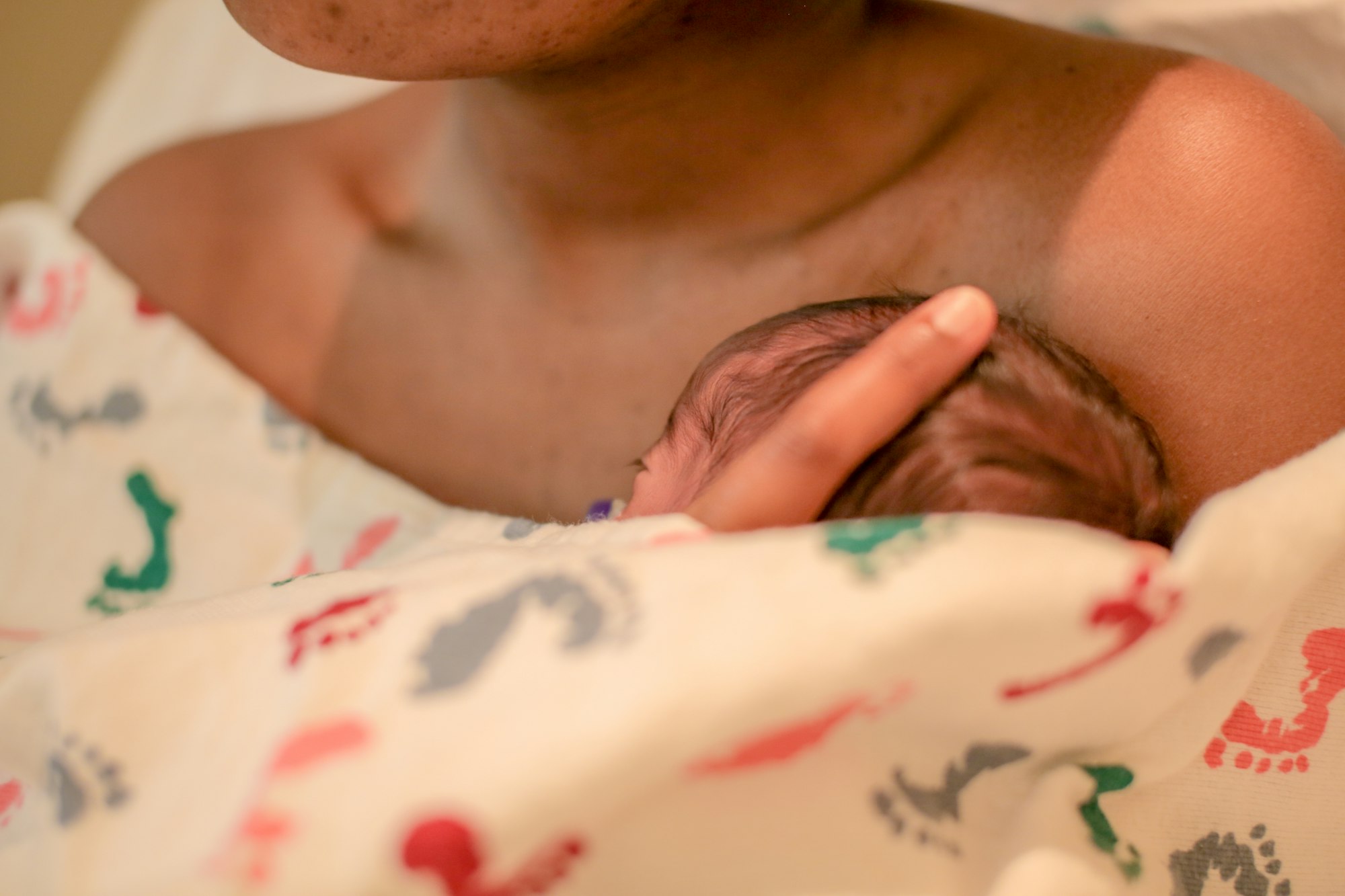Why Is Skin-to-Skin Contact Important?
With skin-to-skin contact, your baby can spend energy on growing and thriving, instead of just surviving.

Skin-to-skin contact is when a baby is placed directly on the mother or father's chest.
All newborn babies crave skin contact. They've spent months inside the warm, cozy home of her womb. But now there's a cold, bright, and very noisy world to adjust to, completely opposite from what they are accustomed to. It's no easy task for such a tiny being. The good news is that mom and dad can help their baby make this transition a little smoother.
How Skin-to-Skin Contact Simulates the Womb Environment
- Your baby will hear your heartbeat,
- He will recognize your voice,
- Be soothed by the movement of your chest as you breathe.
- Your body regulates your baby's temperature to stay warm and constant.
Skin-to-Skin at Birth
It doesn't matter what type of birth you have, vaginal delivery or cesarean section; you and your baby can benefit from this type of care.
Unless there is some medical reason that won't allow it, you should be allowed to have skin-to-skin time while being stitched up after a cesarean.
If you feel a bit overwhelmed by it all right after giving birth, you don't have to feel rushed. The benefits do not change if some time passes before you and your baby spend skin-to-skin time together. However, certain things happen immediately following birth when you can practice skin-to-skin care. (Such as when your baby becomes colonized with your bacteria first and not with the bacteria from the hospital environment.)
In our western culture, we've come to believe that it is normal for a mother and baby to be separated after birth.
We try to convince ourselves that today's technology ensures a baby's survival. Yet research repeatedly proves that all babies, especially premature babies, do far better when they are in constant contact with their mothers.
The fact is that a baby can be cared for medically on a mother's chest. In only sporadic cases, it is not possible or beneficial.
Babies who are in skin contact with their mothers, thrive better, heal quicker and stabilize much easier than when placed in incubators.
Biologically, separation is just not normal at all. The mother and her baby should be viewed as a dyad or pair, not as two separate persons (or patients).
The mother was the environment while her baby was growing inside her tummy, and she should continue to be the environment for her baby after birth.
I love the way Dr. Nils Bergman puts it. He says that skin-to-skin contact is not better than separated care. Separated care is worse. Being separated from the mother is standard practice, as in common practice, but it is by no means normal biologically.
If you had biology in school, you've probably learned about our basic biological needs: warmth, food, and shelter. Amazingly, skin-to-skin contact with mom, breastfeeding, and Kangaroo Mother Care provides precisely this!
So your baby can spend energy growing and thriving instead of just surviving.

The Tushbaby Hip Carrier
With its ergonomic design and comfortable waistband, Tushbaby provides optimal support for you and your baby. Say goodbye to shoulder and back pain from traditional carriers, as Tushbaby evenly distributes your baby's weight, relieving strain and promoting better posture.
The Benefits of Skin-to-Skin Contact
- The mother's skin provides warmth that is not only a way of maintaining the baby's temperature but also provides calories to the baby.
- Her breasts always provide the perfect nutrition for her baby, changing as needed. The first milk, colostrum, has protective properties; after that, her 'mature' milk comes in, which has different properties.
- While she breastfeeds her baby, she also falls in love with that little person and will protect them with her life.
The Benefits for Baby
- Breathing is more effortless and rhythmic.
- Heart rate is more likely to remain normal.
- Oxygen levels improve.
- They can maintain their blood sugar levels.
- Maintain their body temperature.
- Their blood pressure remains normal.
- It has an analgesic effect on babies, meaning their pain threshold rises.
- The same bacteria colonize the baby as their mother, not the harmful bacteria from the hospital environment.
- Breastfeeding is off to a good start sooner and for longer.
- It promotes bonding.
- These babies cry less and are generally calmer.
- And most of all, it is soothing to all involved.
These benefits apply to all full-term newborn babies. But, skin-to-skin care becomes even more critical and crucial for their health when a baby is premature or has a low birth weight. In this case, Kangaroo Mother Care should be implemented.

Skin to skin With Dad?
Dads can also provide skin-to-skin care for their babies.
A mother and father complement each other when they can work together in raising their child because each provides differently for the baby, producing a well-balanced person.
If the mother cannot hold her baby after a cesarean or due to another birth complication (whether vaginal or c-section), or if she feels overwhelmed at first, the father can hold his baby skin to skin.
If they are parents of multiples (twins, triplets, or more), the father can help out even more. Each parent can take turns holding the baby skin to skin.
New research shows that this practice is more beneficial for a baby than being put in a crib or incubator. Except for the nutritional part (i.e., breastfeeding), the father's body still provides all the other benefits. But it is possible for him to feed the baby expressed breast milk or formula, using either a cup, syringe, nasogastric tube, or bottle.
The Breast Crawl
When held skin-to-skin after birth, babies instinctively demonstrate some behaviors in a specific order. Here I'll explain those stages to you...
Stage 1
Birth Cry
Do you know that sound every single parent loves to hear most?
The very first cry of your brand new baby, telling you that their lungs have expanded and they are alive and well.
Stage 2
Relaxation
The baby has stopped crying; they are snuggling close to the mother's skin (maybe only covered with a blanket)
The mother and her baby relax. Not much hand or mouth movements from the baby, just a moment of serenity and bliss.
Stage 3
Awakening
The baby starts to wake up and move a bit. Their eyes might open, moving their head and shoulders, hands and mouths.
This is more or less about 3 minutes after birth.
Stage 4
Activity
Now you will start to see the rooting reflex as your baby shows more mouth movements and even some suckling movements.
The baby will move around more to get to the breast and start breastfeeding more or less about 8 minutes after birth.
Stage 5
Rest
At any time during the first hour after birth, the baby will have periods of rest.
Stage 6
Crawling
Now the baby is trying to get to that liquid gold (AKA breast milk). Making lots of body movements, the baby will work its way closer to the breast and nipple.
When the baby moves like this, it triggers the mother's oxytocin levels, and her breasts get the message to start producing the milk. How awesome is that?! This happens more or less 35 minutes after birth.
Stage 7
Familiarization
The baby gets to know their mother by licking her breast and getting acquainted with her scent and milk smell.
The baby also uses their hands to massage and feel the breasts, which triggers the let-down reflex. This stage lasts up to 20 minutes and happens about 45 minutes after birth.
Stage 8
Suckling
Finally, the baby is at the breast and ready for their first feed. The baby latches on by themselves and starts to suckle at the breast, rewarded by the sweet-tasting, all-important colostrum. Goal achieved. This stage may take a while, depending on whether or not the mother had any pain medication or anesthetic. But, it usually starts about one hour after birth.
Stage 9
Sleep
A satisfied baby and a happy mommy. The baby (and maybe mom too) fall blissfully asleep more or less one and a half to two hours after birth.
Even though it's preferable that nobody interferes in any way with mom and her baby at this time, it is essential to have a professional such as a doctor or nurse present, just in case help is needed. And especially if the mother has had any medication during the birth or if she had a cesarean section.
Your Birth Plan
If skin-to-skin after birth appeals to you, be sure to write it in your birth plan and find out if your caregiver will grant your requests ahead of time.
The sad thing is that not everyone is familiar with skin-to-skin care's positive effects. So, you need to inform yourself and make sure that you make your wishes known to the staff and doctors that are going to be involved in your baby's birth.
Tell them that you have researched the benefits of skin-to-skin contact directly after birth and wish to have at least an hour or two of immediate, uninterrupted time with your baby with as little delay as possible.
You can also ask them to give all medications to your baby while on your chest (like the eye ointment and Vitamin K); after that, the baby can be weighed.
Remember, this is YOUR baby. YOU have a say and the most important one! Speak up and make your wishes known before and after the birth. If your partner or doula is with you, ask them to help ensure that your wishes are met.
As soon as your baby is born, they should be dried off and placed directly onto your chest. You both can be covered with a blanket or towel if the room isn't comfortably warm.
If you had a vaginal delivery, you could have your baby lying vertically on your abdomen or chest while you deliver the placenta. And if you need any stitches due to a tear or episiotomy, this can also be done while you hold your baby to your skin, getting to know each other.
It is also possible to practice skin-to-skin contact after a c-section, although you will have to discuss this with your doctor beforehand and make sure that your wishes are made known to all the staff that will be present.
Once you are moved into recovery, you can allow your baby to try and latch on by themselves.
When babies can latch on this way, they usually latch on well. When they latch on well, they immediately start to breastfeed, which results in higher blood sugar levels, and your breastfeeding journey is off to a great start!
After giving birth, you will be flooded with the after-birth hormones. Having your baby skin-to-skin has such a calming effect that your confidence is boosted, and you will feel relaxed.
So awesome and almost magical!
